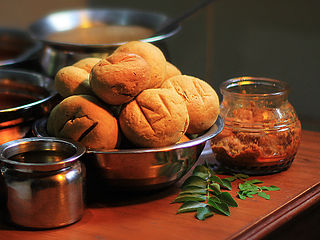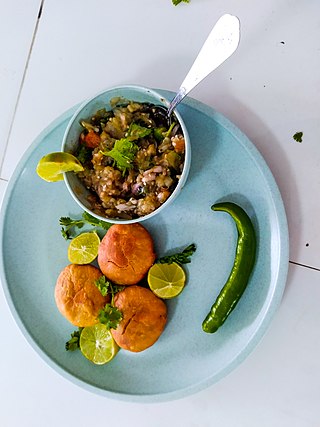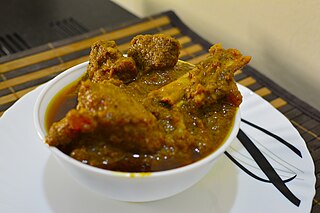Indian cuisine consists of a variety of regional and traditional cuisines native to the Indian subcontinent. Given the diversity in soil, climate, culture, ethnic groups, and occupations, these cuisines vary substantially and use locally available spices, herbs, vegetables, and fruits.

Raita is a side dish in Indian cuisine made of dahi together with raw or cooked vegetables, fruit, or in the case of boondi raita, with fried droplets of batter made from besan.

Chaat, or chāt is a family of savoury snacks that originated in India, typically served as an hors d'oeuvre or at roadside tracks from stalls or food carts across South Asia in India, Pakistan, Nepal and Bangladesh. With its origins in Uttar Pradesh, India, chaat has become immensely popular in the rest of South Asia.

Rajasthani cuisine is the cuisine of the Rajasthan state in North West India. It was influenced by various factors like the warlike lifestyles of its inhabitants, the availability of ingredients in an arid region and by Hindu temple traditions of sampradayas like Pushtimarg and Ramanandi. Food that could last for several days and could be eaten without heating was preferred.
Maharashtrian or Marathicuisine is the cuisine of the Marathi people from the Indian state of Maharashtra. It has distinctive attributes, while sharing much with other Indian cuisines. Traditionally, Maharashtrians have considered their food to be more austere than others.

Baati is a hard, unleavened bread cooked in most areas of Rajasthan, and in some parts of Madhya Pradesh and Gujarat states of India. It is prized for its long shelf life and high nutritional content, and, in desert areas, for the minimal quantity of water required for its preparation. Baati is commonly eaten with dal, hence also referred to as dal baati. In some regions, especially Madhya Pradesh, it is also paired with a roasted aubergine mash called bharta. Baati is also closely related to Litti (cuisine), popular in eastern Uttar Pradesh (Varanasi) and western Bihar. Litti is eaten with potato, tomato and roasted aubergine.

Kadhi or karhi is a yogurt-based dish originating from Rajasthan, india. It's made by simmering yogurt with besan and indian spices until it forms a thick, tangy gravy. Sometimes, it's also mixed with pakoras. It is often eaten with cooked rice or roti.
Bhojpuri cuisine is a style of food preparation common among the Bhojpuri people of Bihar, Jharkhand and eastern Uttar Pradesh in India, and also the Terai region of Nepal. Bhojpuri foods are mostly mild and tend to be less hot in terms of spices used. The cuisine consists of both vegetable and meat dishes.

Churma is a popular Rajasthani, Bihari, Uttar Pradesi, Haryanvi, and Awadhi delicacy from India. In Punjab, the dish is called churi. It is coarsely ground wheat, crushed and cooked with ghee and sugar.

Mirchi Bada or Mirchi Vada is a vegetarian fast food dish native to Jodhpur in the Indian state of Rajasthan. The dish is made by stuffing a green chili with indian spices, mashed potato, and gram flour, then it is wrapped in besan batter and fried until golden brown. It is served hot with tomato sauce or occasionally with mint and tamarind chutney. Banana pepper and Bhavnagri chillis are used for making mirchi bada.
Sattu is a type of flour, mainly used in India, Nepal, Tibet and Pakistan. Sattu is a type of flour made up of dry roasted and ground pulses and cereals. The dry powder is prepared in various ways as a principal or secondary ingredient of dishes. Sattu is used in vegetarian cuisine as it can be a source of protein.

Baigan bharta, also spelled bainganbharta or baigan chokha is an Indian dish prepared by mashing or mincing grilled eggplant (baigan) with tomato, onion, herbs and spices, with variations being common from chef to chef. Traditionally, cooking the eggplants over charcoals, inside of a tandoor, barbecue grill or oven, or even directly applying flame to the outside of the fruit infuses the dish with a smoky flavour; the blackened skin is then easily peeled and the eggplant may be further prepared.
Bihari cuisine is eaten mainly in the eastern Indian state of Bihar, as well as in the places where people originating from the state of Bihar have settled: Jharkhand, Eastern Uttar Pradesh, Bangladesh, Nepal, Mauritius, South Africa, Fiji, some cities of Pakistan, Guyana, Trinidad and Tobago, Suriname, Jamaica, and the Caribbean. Bihari cuisine includes Angika cuisine, Bhojpuri cuisine, Maithil cuisine and Magahi cuisine.

Litti is a whole wheat flour dough ball stuffed with a spiced mixture of sattu. Litti, along with chokha, is a complete meal that originated from the Bhojpuri region of the Indian states of Bihar and Uttar Pradesh. It is also a popular street food in small towns and cities.

Gujarati kadhi is a Gujarati version of kadhi. It is a very popular Gujarati dish made from buttermilk or dahi (yogurt) and gram flour. Kadhi is an essential part of Gujarati cuisine.

Mutton curry is a dish that is prepared from goat meat and vegetables. The dish is found in different variations across all states, countries and regions of the Indian subcontinent and the Caribbean.

Besan or gram flour is a pulse flour made from chana dal or chickpea flour or brown/kaala chana, a chickpea. It is a staple ingredient in the cuisines of the Indian subcontinent, including Indian, Bangladeshi, Burmese, Nepali, Pakistani, Sri Lankan and Caribbean cuisines.

Maithil cuisine, also known as Mithila cuisine, is a part of Indian and Nepalese cuisine. It is the traditional cooking style of Maithils residing in the Mithila region of the subcontinent.
















